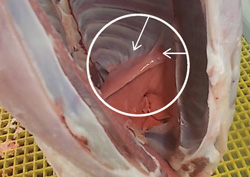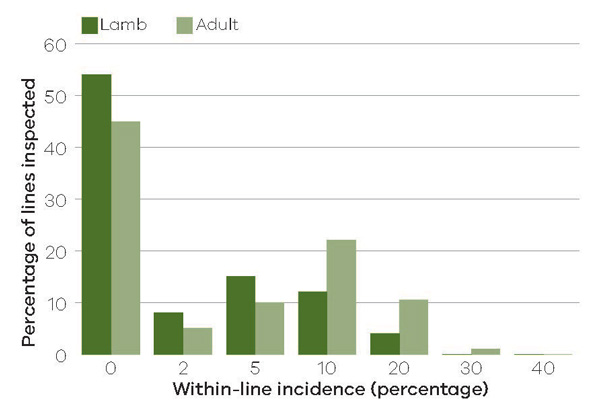Pleurisy in sheep at slaughter

The National Sheep Health Monitoring Project has been collecting data on the incidence of pneumonia and pleurisy in sheep at slaughter since 2013. Data is also collected on a number of other conditions (see previous articles in Sheep Notes), such as vaccination lesions, arthritis and caseous lymphadenitis (CLA or cheesy gland). Producers are now receiving these reports from inspected lines through a program administered by the Livestock Biosecurity Network and Agriculture Victoria, sponsored by the Sheep and Goat Compensation Fund.
Pleurisy is inflammation of the lining of the chest cavity, and is seen at slaughter as translucent bands joining the lungs to the insides of the ribs. It usually occurs in conjunction with pneumonia, which makes the sheep quite sick. Many sheep recover from pneumonia, so all that is seen at slaughter is the residual pleurisy.
Normally, the lungs drop away cleanly from the carcase when it is eviscerated at slaughter, but this doesn't happen in a sheep affected by pleurisy. In a recent study by Meat & Livestock Australia (MLA) in South Australia, two-thirds of carcases affected by pleurisy needed to have some of their ribs cut away. This can affect one of the most expensive cuts derived from a sheep carcase: 'frenched' lamb chops.
The study found that the average amount trimmed was 1.0kg, at a cost of $6 per carcase to the producer, and a loss of around $10/kg to the processor in these high-value cuts. Even if the ribs weren't trimmed, about 0.7kg of carcase weight was lost.
Figure 1 shows the incidence of pleurisy in 11,547 inspected lines of directly consigned Victorian sheep (both lambs and adults). Half of the lines had no evidence of pleurisy. Among affected lines, nearly 7% of carcases had pleurisy; higher percentages were seen in adult sheep than in lambs.
Note: Total number of sheep inspected was 11,547.

Pleurisy and pneumonia are usually caused by infection with one or more of a range of bacteria and viruses. The bacteria include species of Mannheimia (which also causes mastitis in ewes and pneumonia in cattle) and Mycoplasma (which can also cause arthritis and mastitis). These bacteria are known as commensals – they are found generally around sheep, and only cause disease under certain circumstances.
Stress is often described in outbreaks of pneumonia, caused by factors such as overcrowding and high temperatures – especially handling and yarding in high temperatures. Dusty conditions have been shown to predispose feedlot lambs to pneumonia. The department received a number of reports of losses due to pneumonia in containment-fed lambs and sheep during the past summer; all of the factors described here may have contributed.
Another cause of pneumonia and pleurisy is inadvertent administration of drenches into the lungs. Advice on good drenching technique is provided in the Livestock Biosecurity Network's fact sheet on pneumonia and pleurisy (see the web address at the end of this article).
Sick sheep or lambs can be treated with antibiotics when they first get the disease, with attention to meat withholding periods for the antibiotics. By the time we see the chronic lesions of pleurisy detected at abattoirs, no treatment is feasible.
To reduce the incidence of pleurisy, pay attention to the stressors that predispose sheep to the condition. This year's experience certainly suggests that it is important to avoid handling and overcrowding sheep on hot days, and keep dust to a minimum.
For more information, read the Pneumonia Pleurisy factsheet on the Animal Health Australia website (select 'Factsheets' then 'Pneumonia/Pleurisy').